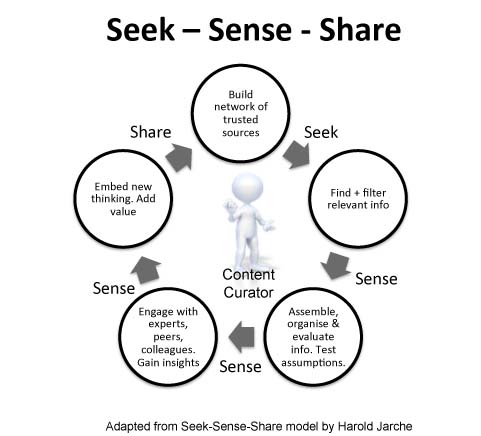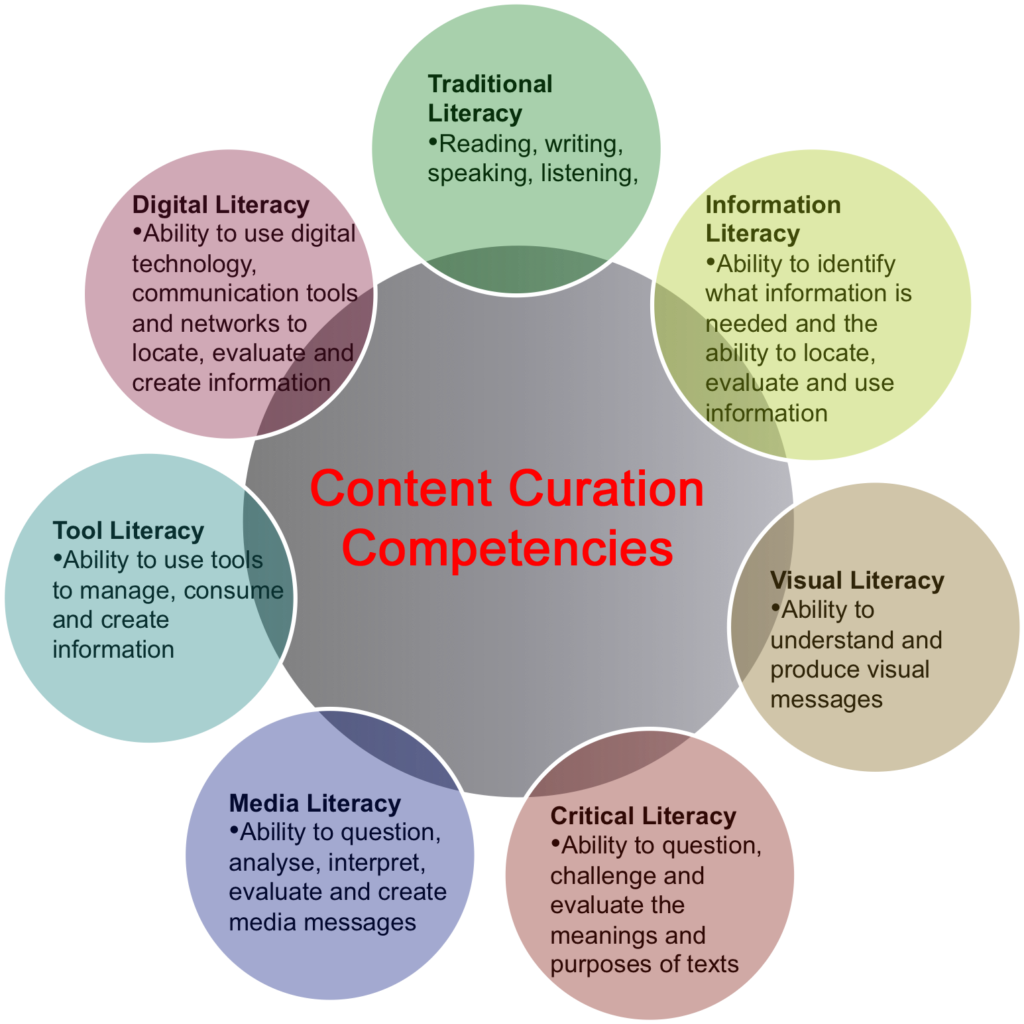Content Curation: the future of relevance
This is an updated version of the article originally published in Business Information Review, January 2015.
Content creation is no longer the exclusive domain of journalists, newspapers and advertisers. As Clay Shirky has famously pointed out, publishing is no longer a job or an industry; it’s a button. We’re all creating content, as originators or commentators, which is then shared and re-shared many times over.
As a result, online publishing is now ubiquitous and incessant, with the consequence that we’re often overwhelmed with raw, unfiltered, context-free information. This is fuelling a demand for new content organisation and consumption methods in order to find meaningful and relevant information in these fast-moving data flows. Relevant and decision-ready information is becoming a valuable commodity in its own right, and many organisations are beginning to appreciate the roles and skills of people who understand the specific information needs of their information consumers and can provide it in a timely and effective manner.
The answer to these needs lies in the disciplines, competencies and skills of content curation. Effective curation requires technology and tools to find, filter and validate content at the speed of the real-time web. It requires knowledge domain experts who can interpret and add insight to the content they are harvesting. It needs people who can utilise the power of networks and networking to source relevant and reliable information. In short, these are the emergent skills of the 21st Century knowledge worker.
What is curation?
When most people think about curators, they usually identify them with museums. Museum curators do not create content in the way traditional instructional designers do. A museum curator keeps abreast of trends, listens to what guests are discussing, and finds resources that resonate well with those areas. He or she scours the globe for artefacts related to the topic, and organises the artefacts in such a way as to take guests on a journey as they experience the exhibit.
In recent years, the definition of curation has expanded, as more information shifts to a digital format. The volume of digital information available makes it increasingly challenging to find the information you are interested in. Curation in a digital world isn’t a luxury; it’s a necessity.
But it’s not only the shift to digital information that has expanded the definition of curation. Social media sharing has enabled anyone to share anything with the world. You don’t need a master’s degree in museum studies to be a curator today; in many respects, all you need to be a curator is the ability to click the “Like” button on Facebook
Curation today is very much like photography. Years ago, if you wanted a quality photo, you hired a photographer. They had the equipment and the expertise to take photos that were just not possible with the cameras available to the average consumer 20 or 30 years ago.
Much like curation, the shift to digital technology changed the photography game. Today cameras (and camera phones) can take pictures of incredible quality; in some cases rivalling what a professional photographer might be able to produce.
Does that mean that there’s no need for a “professional” photographer or curator? Absolutely not. Their expertise and training has value, especially in specific high-value situations. But the reality is, just as tools exist today that enable the average individual to take a quality photo, we now have tools that enable an individual to curate information.
Technology has enabled anyone with an Internet connection to become a curator.
Why Curate?
“In a world of bandwidth and content abundance, we’re overwhelmed with data, tweets, blogs, check in’s and media. It used to be we surfed the web. Now the waves of the web are just too big. Curation is the new magic that makes the web work. Bringing the web back to human scale with human filters you trust and love. A powerful mix of passion and context turns noise back into signal.” A quote from the renowned author and content curator Steve Rosenbaum.
So how much information is really out there? Well, according to IBM, we create 2.5 quintillion bytes of data every day and the majority of this data (90 per cent) has been created in the last two years alone. Looking at social media, very second, on average, around 6,000 tweets are tweeted on Twitter (visualise them here), which corresponds to over 350,000 tweets sent per minute, 500 million tweets per day and around 200 billion tweets per year. Add to this the content from over 2.23 billion monthly active Facebook users and you start to get a picture of the scale of information swirling around the Internet.
Information overload is disorienting our lives and making it increasingly difficult for us to find the right information, when needed. No wonder many employees are feeling overwhelmed on a daily basis by documents, discussions on social tools, images and videos. Clearly the content burden is an issue that needs to be fixed. We need to separate the signal from the noise. We want to be able to take actionable decisions based on good quality information. Taking a drink from the raw, unfiltered, context-free Internet fire-hose is no longer a viable option for any of us. In today’s world of content abundance, the skill of how to find, make sense of, and share content that we need to be effective in our work is critical.
Simply put, being a content curator is a method to help us stay informed about our fields of interest and be more effective at our jobs. Content curation provides a structure, a process, a system and a discipline to help us find (and use) more relevant information.
It’s likely that most of us are already consuming curated content. This might be trending news items on Facebook or Twitter, or top ten lists on YouTube, Buzzfeed, or Mashable. We’re relying on crowdsourced content in the form of number of views, number of “likes” and frequency of user comments to identify trends and memes. This is one way of picking out a signal, but it’s important to remember that much of this is system automated, i.e. algorithmically derived, and consequently the quality, accuracy and relevance of the content is only as good as the algorithm.
The real benefit of content curation is dependent on the skills, knowledge and competencies of the human content curator. Social media has given us the tools to find and filter raw content, but it can’t tell us what is right or what is useful. We have to utilise our own knowledge and experience of the world to apply critical thinking and “sense” what is useful and relevant. We have to use our brains to make the connections between non-linear and asynchronous articles, stories and events. This is also how we learn, and consequently why many people use content curation as part of their personal/professional development, sometimes referred to as “personal knowledge management”, PKM or self-directed learning.
What I’ve described so far are the “seeking” and “sensing” elements of the content curation process. The third element – “sharing” is where the content curator is consciously curating on behalf of a defined audience. This might typically be an online community, a department in an organisation, your managers or leaders, your blog followers etc. The important thing about sharing is that the content curator has added some value to what is being shared, i.e. it’s not merely a regurgitation of content that has been found. It includes some insight to the content, even personal opinion. The more consummate content curators will use storytelling techniques to join up the dots between what might have been several disparate content sources.
As an aside, the “seek-sense-share” model has been widely promoted as a personal learning process by Harold Jarche.
I should probably make it clear at this point that you don’t have to be called a “Content Curator” in order to curate content, though I am aware that some organisations have introduced this as a job role. As an online community facilitator, for example, you may already be finding and sharing information for a community that recognises and appreciates delivery of content that is focused and relevant.
However you look at this question of “why curate”, it’s quite clear that relevant and decision-ready information is becoming a valuable commodity in its own right, and many organisations are beginning to appreciate the roles and skills of people who understand the specific information needs of their information consumers and can provide it in a timely and effective manner.
But perhaps the final word on the “why” of content curation is summed up in this blog post by Steven Rosenbaum, originally published on Videolink.
The Five Laws of the Curation Economy
The First Law: People don’t want more content, they want less. We’re overwhelmed in raw, unfiltered, context-free data. Humans want it to stop.The Second Law: Curators come in three shapes. There are Curation Experts — people whose background and depth of understanding makes their curatorial choices valid. If you’re looking for medical advice, you want your video viewing curated by a doctor, not a patient. There are Editorial Curators, who manage the voice and the collections of the publications and sites they organize. And there are Passion-Driven Curators, they love their particular area of focus and attention and bring that single-minded focus to every piece of content they touch
The Third Law: Curation isn’t a hobby; it’s both a profession and a calling. Curators need to be paid to be part of the emerging ecosystem. What’s a fair fee will depend on how critical the curator’s output is in the category. But an economic basis is essential, and inevitable.
The Fourth Law: Curation requires technology and tools to find, filter, and validate content at the speed of the real-time web. Curation can’t simply be a human with a web browser — the mix of man and machine is essential here.The Fifth Law: Curation within narrow, focused, high-quality categories will emerge to compete with the mass-media copycats who are filling the curation space with lists, cat videos, and meme links.
The simple fact is this, the web used to be a relatively closed community of makers. In the past, anyone could browse the web, but content creators needed to have tools, literacy, and time to create and publish. In the past few years, the growth in mobile devices along with the widening definition of content from contextualised data to raw data has opened the floodgates of participation.
The cure for information overload is coherent curation, data-driven discovery managed by skilled, thoughtful, and in some cases expert curators. Curate or be curated – that’s the new face of digital content in the always-on world”.
Different types of curation
Curation has many layers, from the simple to the complex, all of which are applicable to workplace learning and performance. Here are five layers described by Rohit Barghava’s in his article “The 5 Models of Content Curation”:
- Aggregation– There is a flood of information online and Google can only give you a best guess at the most relevant, but there are millions and millions of pages returned for any search result. Aggregation is the act of curating the most relevant information about a particular topic into a single location. Often taking the form of catalogue style blog posts which list “27 Great Resources For Small Business” (or similar aggregations), this is the most common form of content curation. Volume is not typically an issue when it comes to aggregation, so in this case you still may have hundreds of pieces of source material – but just the fact that it is in a single location and not millions of pieces of information has a high value for people interested in a particular topic.
2. Distillation– The idea behind distillation is that adding a layer of simplicity is one of the most valuable activities that someone can undertake. Distillation is the act of curating information into a more simplistic format where only the most important or relevant ideas are shared. As a result, there may be quite a bit of additional content that is lost for the sake of simplicity – however the value comes from the fact that anyone digesting this content no longer has to contend with a high volume of content and can instead consume a more focused view of information.
3. Elevation– The smaller ideas that are often shared online in 140 character bursts or pithy mobile phone images may point to a larger societal trend or shift. Elevation refers to curation with a mission of identifying a larger trend or insight from smaller daily musings posted online. Encompassing much of what many trend-focused websites do, this can be one of the hardest forms of content curation because it requires more expertise and analytical ability on the part of the person or organisation during the curating. The benefit is that it can also be the most powerful in terms of sharing new ideas as well.
4. Mashup– A term often used in the context of music to describe the growing trend of taking two or more pieces of music and fusing them together – there is a wider implication for mashups in relation to information. Mashups are unique curated juxtapositions where merging existing content is used to create a new point of view. Taking multiple points of view on a particular issue and sharing it in a single location would be one example of this type of behaviour – and could be used to describe the sort of activity that takes place every day on Wikipedia. More broadly, mashups can offer a way of creating something new while still using content curation as a basis for it because you are building on existing content.
5. Chronology– One of the most interesting ways of looking at the evolution of information is over time – and how concepts or our understanding of topics has changed over time. Creating a Chronology is a form of curation that brings together historical information organized based on time to show an evolving understanding of a particular topic. Most useful when it comes to topics where understanding has shifted over time, this can be a powerful way of retelling history through informational artefacts that exist over time to prove how experiences and understandings have changed.
Curation as a digital competency
Content curation is still largely misunderstood by many organisations and relatively few have recognised this as a job role, function, skill or competency. Much of it happens under the radar, where workers are (sometimes unwittingly) using curation techniques as part of their personal learning journey. Finding and assembling useful and relevant information artefacts for ‘sense making’ and engaging with on-line communities is all part of this journey. Organisations that have recognised the benefits of self-directed learning over more traditional classroom training are more likely to approach content curation as a skill that needs to be developed in their workforce, and (probably) more willing to allocate resources to this activity.
At this point it might be worthwhile differentiating content curation as a self-directed learning activity to the “business” of content curation. There are a growing number of organisations – particularly in the Social Media sector – that sell content curation as a value-added service to their clients and users. These will be typically providing marketing, brand awareness and customer community services. Examples include Mashable, Buzzfeed The Guardian #smartakes and Storyful, but there are many others in what is still a growing sector. However, the core skills are the same, whether curation is part of a business process or part of self-directed learning.
So what are these skill sets? I believe there are five fundamental skills or competencies required for effective content curation:
- Use of tools (social media, search, syndicated feeds etc.) to find and filter relevant information.
- Organising information – categorisation, tagging, scheduling etc.
- Networking – participating in personal and professional networks to enhance and improve learning.
- Critical thinking and sense-making.
- Adding insight and value through storytelling techniques.
It is no accident that all of these competencies align very closely with those of the knowledge or information professional, and consequently why these roles are particularly suited to that of a “Content Curator”.
Content Curation Competencies
Source: Dr Daniel Churchill
Content Curation Tools
There are a wide variety of content curation tools, platforms and services that can be used to curate digital content. These tools vary in many ways, including what data sources they can pull from, where they can share, and who has access to them, to name a few. However, most fall into a few key categories (not an exhaustive list):
Finding, Aggregating and Organising Tools
Feedly has become well known as the RSS aggregator successor to Google Reader. It is a content curation tool that has specialized on the collection of content for the user to evaluate. As well as doing a good job of keeping track of RSS feeds you wish to follow, Feedly also offers a search engine which allows users to search for additional sources of information on a topic. These new finds can then be added to your feed as well.
Hootesuite and Tweetdeck are examples of social media aggregation tools. They help keep track and manage many social network channels. They can monitor what people are saying about you, your topics or your brand. You can view streams from multiple networks such as Facebook, Twitter and Google+ and post updates or reply directly
Evernote is one of the most well known online note-taking applications, alongside Google Keep and Microsoft’s OneNote service. With Evernote, you can use as few or as many of the advanced note management tools as you like. A wide variety of Evernote’s advanced tools are available free to users, but the real power come from the paid for Premium service.
Diigo is a powerful information capturing, storing, recalling and sharing tool. Features include: saving important website URLs; categorising websites by titles, notes, keyword tags, lists and groups; searching through bookmarks to quickly find desired information; saving a screenshot of a website to see how it has changed over time; annotating websites with highlighting or virtual “sticky notes”; viewing any annotations made by others on any website visited; sharing websites with groups or the entire Diigo social network; commenting on the bookmarks of others or soliciting comments on shared bookmarks.
News Discovery Tools
LinkedIn part of it’s acquisition of the ‘Newsle’ service, LinkedIn sends news updates to users about connections in their social networks. Whenever a friend or contact is mentioned in a news article, LinkedIn will send an e-mail about it in near real-time.
Flipboard allows users to create their own personal magazine. Articles, blog posts, photos and other media can be aggregated to create attractive, professional-looking layouts in a digital magazine style. See the Flipboard magazine on the topic of Content Curation[20].
News Curation and Newsletter Tools
Paper.li combines entries from Twitter hashtags, photos, blog and newsline articles and Facebook into a magazine-style layout.
Scoop.it fills the need that a growing number of people and businesses have to publish content in an efficient and impacting way using big data semantic technology that helps them quickly find relevant content
Goodbits links with MailChimp to support simple and easy creation of newsletters. A bookmarklet enables capture and annotation of weblinks and content which are then assembled into the newsletter.
Wakelet – a replacement for the the now defunct Storifyallows the aggregation of text, video and images from many platforms including Twitter, YouTube and Facebook along with user content that relates the items together into a story or timeline.
List.ly helps bloggers & brands curate, crowdsource, and engage readers via live embedded list content inside blog posts.
Visual Curation Boards
Pearltrees This visual and collaborative curation tools allows users to collect, organise and share any URL they find online, as well as to upload personal images and notes I manage a curated Pearltree on the topic (you’ve guessed) Content Curation[26].
Pinterest offers both the ability to easily add photos and graphics to topical pin-boards. It also provides a search facility for other boards that have new items fitting your topics.
Keeeb a visual bookmarking tool and community.
Social Publishing Hubs
Rebelmouse allows users to create a blog, website or social page in seconds by connecting their social networks such as Twitter, Facebook, Instagram, Google+ and LinkedIn.
Networks
Personal Networks – for example, Facebook, Twitter, LinkedIn, Google+. People naturally learn from each other, and social media has removed the requirement of face-to-face meetings to connect with others. These expanded relationships have enabled the building of personal learning networks – selected groups of relationships that an individual counts on in the pursuit of on-going personal development and learning. People often use these networks as a source of curation, in some cases even more than any other resource.
Summary
Curation comes in many forms, from crowd-sourced lists and aggregated collections to authored stories that provide new and insightful perspectives on previously published material. Content curation can be used as a personal competency, to help us develop our understanding of this information rich, time poor world we live in. Relevant and decision-ready information is becoming a valuable commodity in its own right, and many organisations are beginning to appreciate the roles and skills of people who understand the specific information needs of their information consumers and can provide it in a timely and effective manner.
It is still early days for curation in our world. Whilst the practices are old, the technologies are often new and as we get to grips with the possibilities that new technologies bring us, it’s easy to see that more opportunities for storing, transforming and sharing resources will become available. Curation, as a skill, is on the verge of becoming a key differentiator for employees; knowledge workers could well be expected to bring their curated insights with them to their next job role. People are making names for themselves as industry experts by the ways in which they curate other people’s work. Telling a story like those you find in themed exhibits in museums and art galleries is most certainly a skill, but increasingly, it is becoming easier for each of us to become consummate content curators.
(See also: Are you a content curator? Slideshare presentation)












One thought on “Content Curation: the future of relevance”
From John Lindsay:
“add that content curation now takes on communities and commentary in social media, and keyword method, which popped up at a seminar and needs perhaps incorporation for those who don’t know cataloguing and classification”.